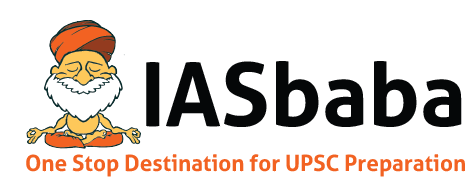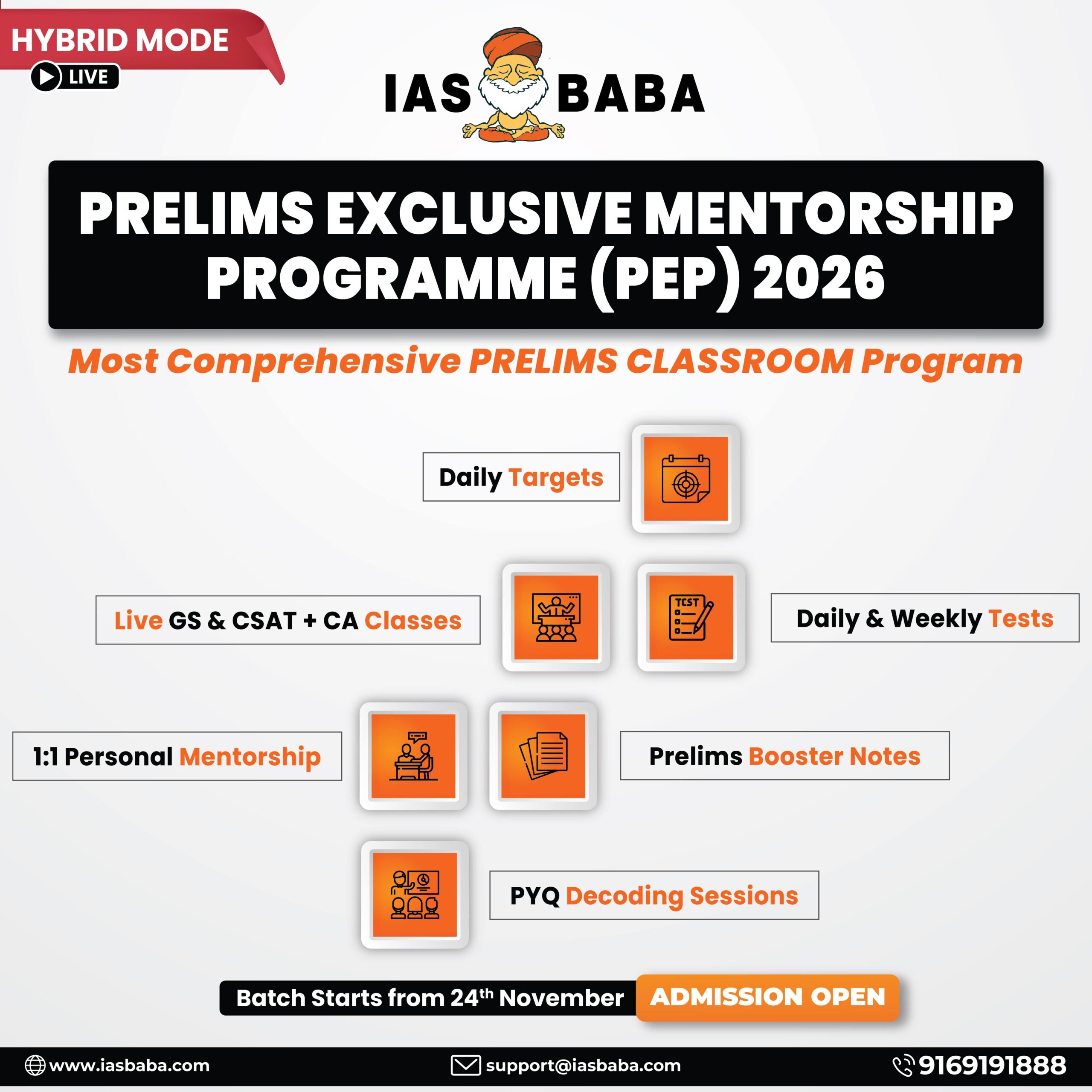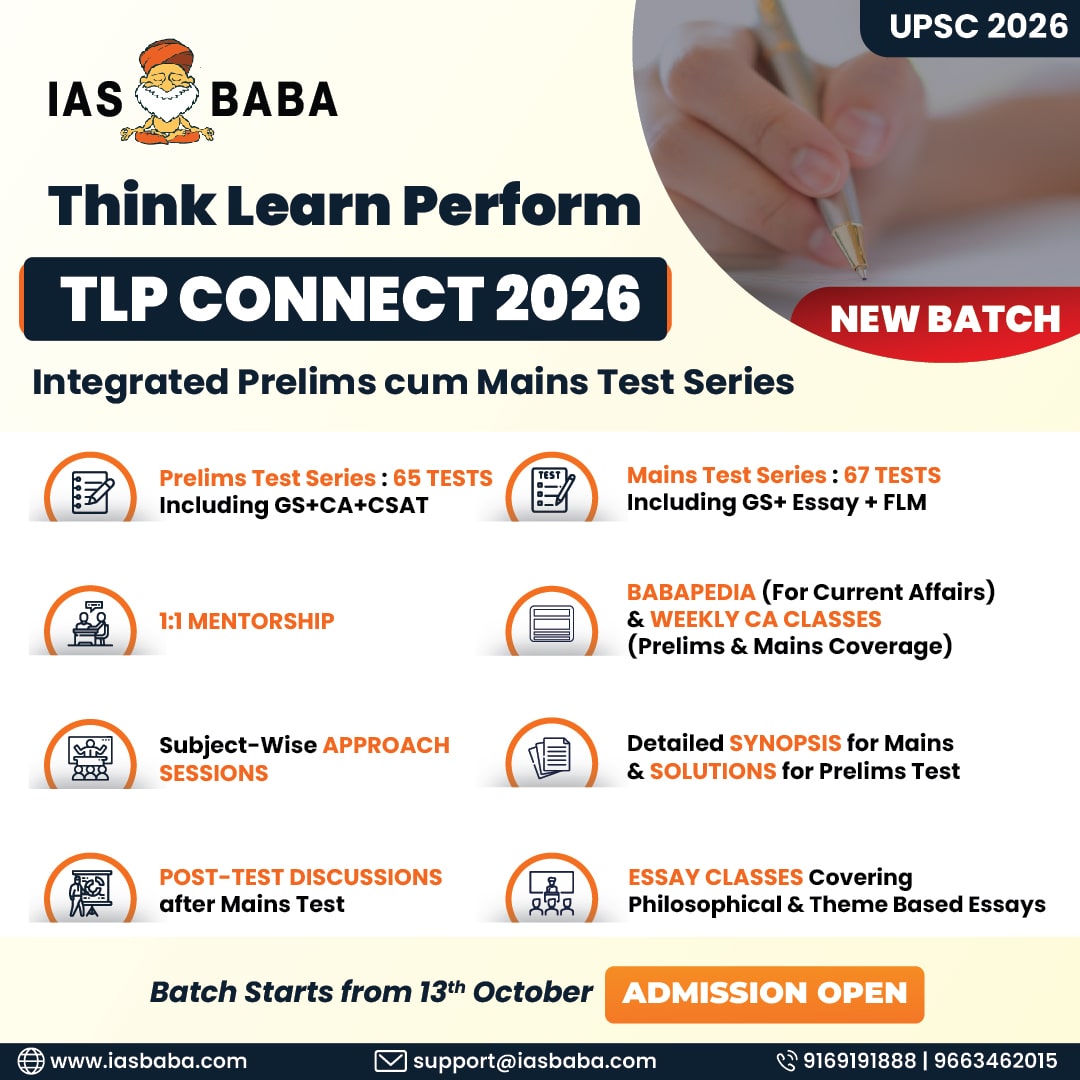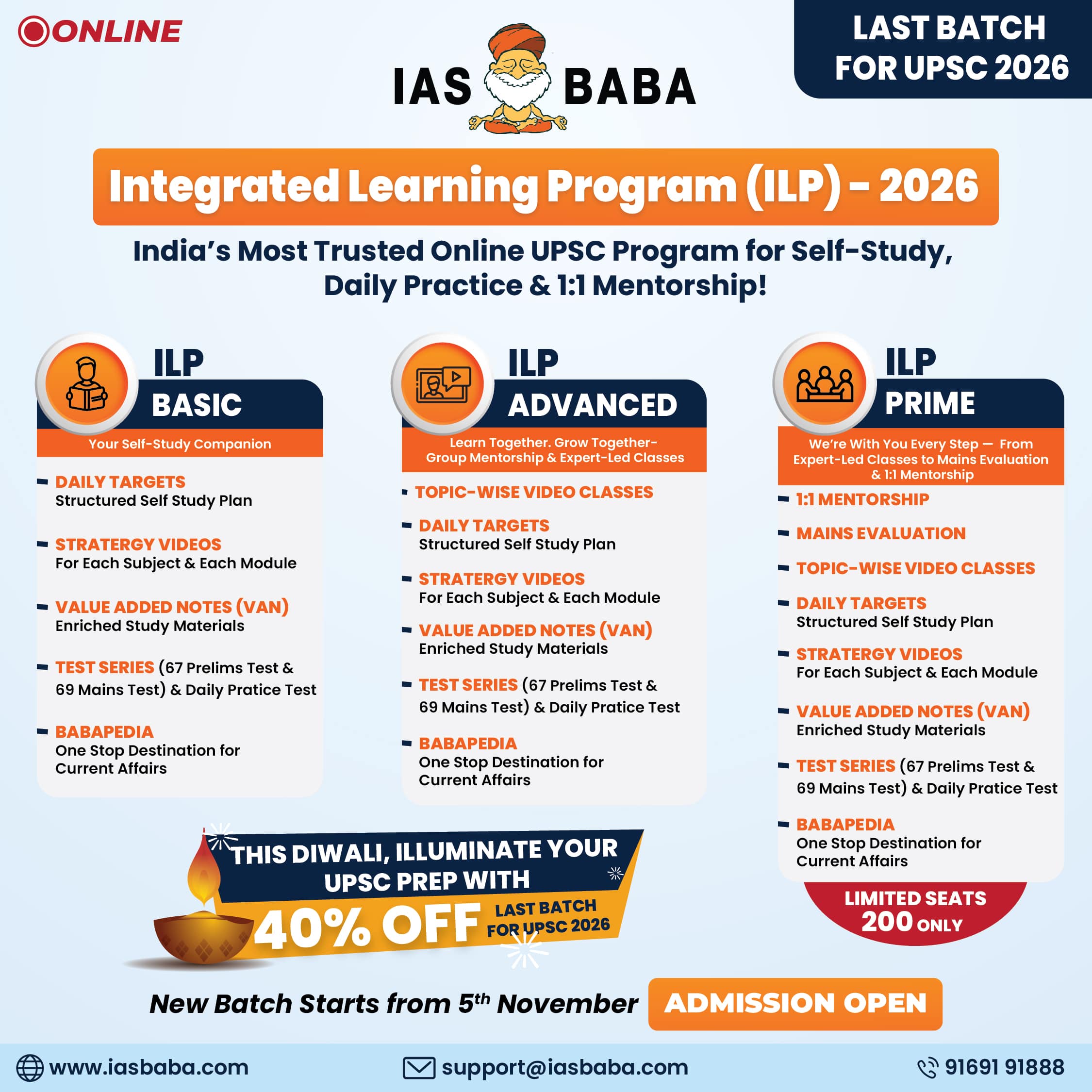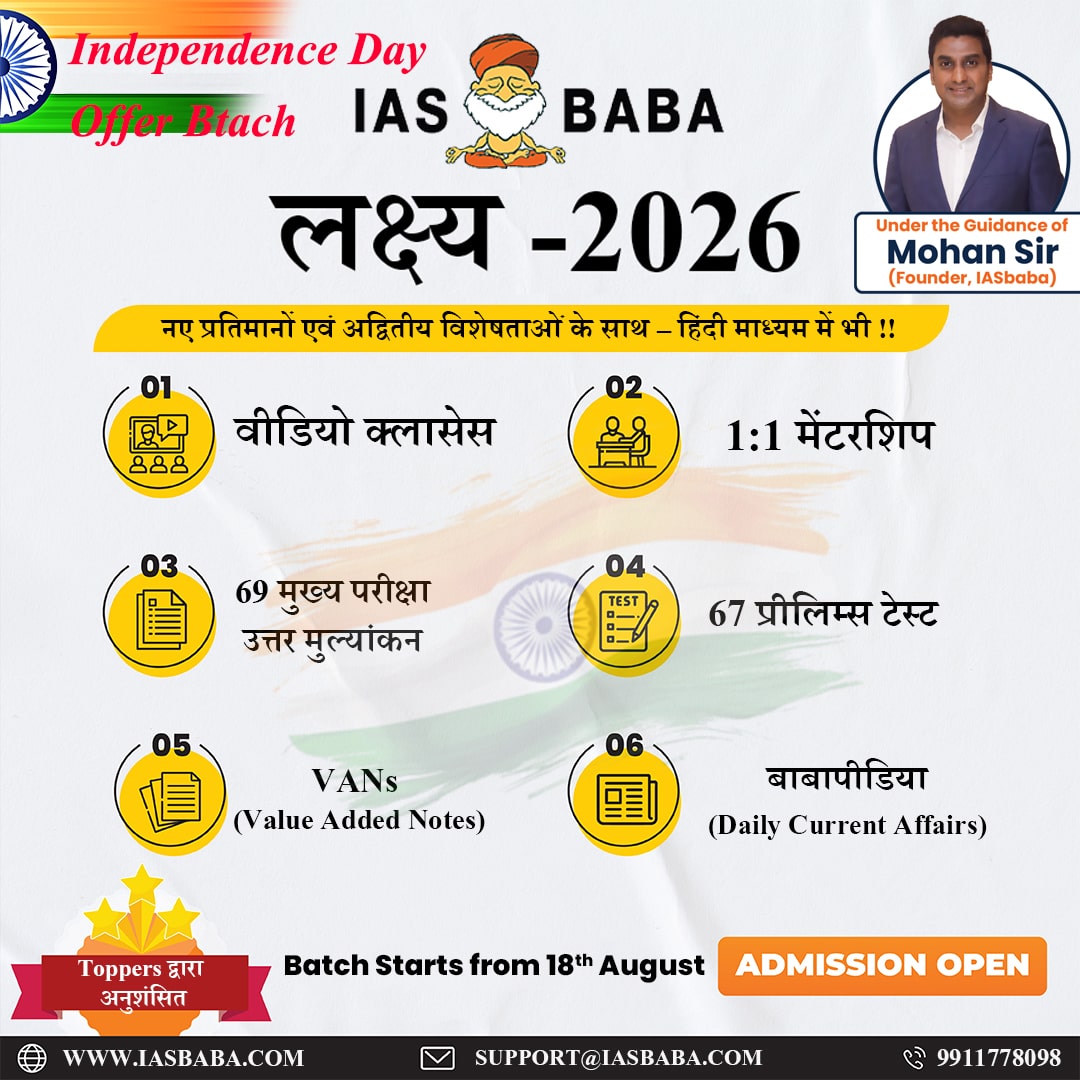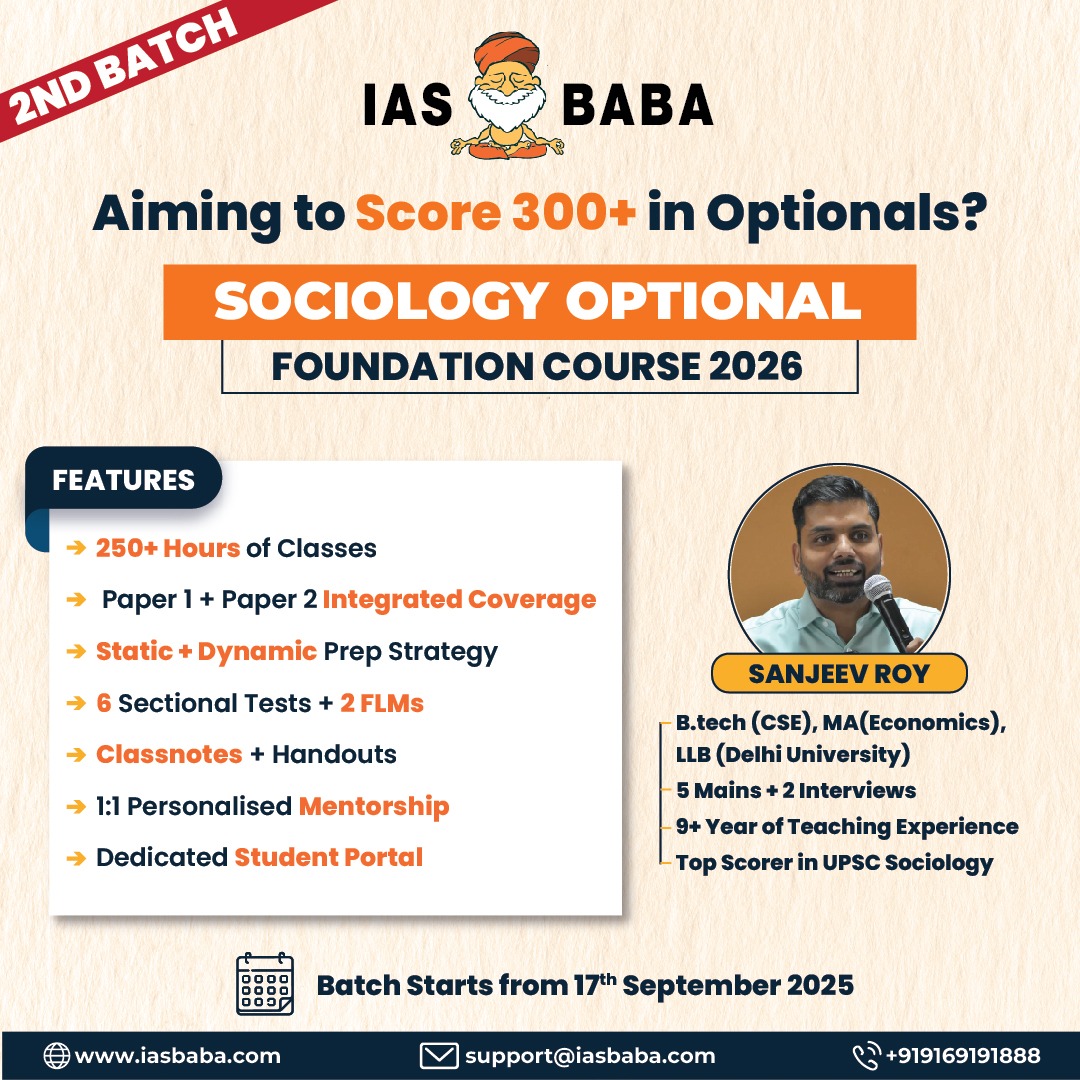IASbaba's Daily Current Affairs Analysis
Archives
(PRELIMS Focus)
Category: POLITY
Context: Registrar-General of India issues notification for Census
Decoding Context:
Overview
- The 16th Census of India will be held in two phases:
- House-listing (March 1 to September 30, 2026)
- Population enumeration (early 2027)
- It will be India’s first digital Census, using mobile apps and a new coding system.
Conducting a Census
- Enumerators: ~30 lakh (mainly school teachers)
- Supervisory Staff: ~1.2 lakh functionaries
- Training: ~46,000 persons
- Preparation Includes:
- Freezing administrative boundaries
- Training
- Methodology revision
Phase 1: House-listing
- Enumerators visit homes to record:
- Type of building
- Use (residential/commercial/mixed)
- Material used
- Water source
- Sanitation
- Electricity
- Head of household info
- Timeline: March 1 – September 30 of the year before population enumeration
- Output: Profile of housing stock, living conditions, amenities
Phase 2: Population Enumeration
- Focus on individual data:
- Name, age, gender, DOB
- Relationship to head
- Marital status, education
- Occupation, religion, caste/tribe
- Disability, migration, nativity
- Goal: Create a full statistical profile of every person in India
Why the Census Matters
- Helps track demographic, social, economic changes
- Assists in:
- Policy-making
- Resource distribution
- Planning welfare schemes
- Basis for:
- Delimitation of constituencies
- Reservation (SC/ST seats under Articles 330 & 332)
- Central grants to states
New Features & Technology
- Mobile App Usage: Replaces paper-based enumeration
- Unique ID generation for entries
- CMMS (Census Management and Monitoring System):
- Supervision
- Issue resolution
- GPS Tagging: Geolocate houses and address data gaps
- Validation & Correction: Real-time error checks during data entry
- Digital Signatures: Enumerators will sign entries digitally
New Information Captured
- Availability of drinking water
- Usage of smartphones and mobile phones
- Access to bank accounts
- Transgender identification option
- Caste enumeration (questionnaire prepared) – pending decision
Political Implications
- First Census Since 1931 to collect caste data beyond SC/ST.
- Timing Critical: Will impact delimitation, reservation in Parliament.
Changes in Content
- Detailed questionnaire was already prepared in 2018-19
- Updated data variables introduced
- Household listing in 2026 will cover 28 columns
Challenges Anticipated
- Digital Literacy: App training for enumerators
- Language barriers in app interface
- Logistics: Device provisioning, supervision
- Exclusion risks: Transient or homeless populations
- Verification: Authenticating digitally recorded data
Conclusion
The 2027 Census will mark a technological shift in India’s data collection process, offering granular and real-time demographic insights. However, its execution will require robust training, digital readiness, and efficient supervision to overcome inherent challenges.
Learning Corner:
Note on the History of Census in India
The Census in India is one of the oldest and most comprehensive administrative exercises in the world. It provides vital data for governance, planning, and policymaking. Here’s a concise overview of its historical development:
Historical Background
- First Attempt (1872):
- The first population count was conducted in 1872 during British rule under the supervision of W.C. Plowden.
- It was not synchronous and was conducted in different provinces at different times.
- First Complete Census (1881):
- Conducted under Lord Ripon, with Sir William Hunter as the Census Commissioner.
- This was the first synchronous and systematic Census across India and marked the beginning of the decennial tradition.
Census in Independent India
- After independence, the first Census was conducted in 1951 under the Census Act of 1948.
- Since then, India has conducted seven Censuses: 1951, 1961, 1971, 1981, 1991, 2001, and 2011.
- The 2021 Census was delayed due to the COVID-19 pandemic and is now expected in 2026–2027.
Census Act, 1948
- Provides the legal framework for conducting the Census in India.
- Empowers the Registrar General and Census Commissioner of India to manage the process.
Key Features of India’s Census
- Conducted every 10 years.
- Two-phase process:
- House-listing and Housing Census
- Population Enumeration
- One of the largest administrative exercises globally, covering over 1.4 billion people.
Significance
- Provides data on population, literacy, migration, employment, housing, and amenities.
- Forms the basis for:
- Policy formulation
- Delimitation of constituencies
- Reservation of seats
- Distribution of central funds
Source : THE INDIAN EXPRESS
Category: ENVIRONMENT
Context: Bonn Climate Change Conference to be held from June 16 to 26, 2025.
Decoding Context:
Purpose & Focus
- Acts as a mid-year preparatory meeting between COP29 (Baku, 2024) and COP30 (Belém, Brazil, 2025)
- Brings together representatives from nearly 200 countries to:
- Advance the Global Goal on Adaptation (from concept to implementation)
- Mobilize climate finance (goal: $1.3 trillion under the Baku-Belém Roadmap)
- Finalize rules for UN-backed carbon markets (Article 6.4 of the Paris Agreement)
- Strengthen Nationally Determined Contributions (NDCs)
Side Themes
- Emphasis on:
- Just transition
- Gender-responsive climate action
- Youth and Indigenous Peoples’ engagement
- Nature-based solutions
Significance
- A key platform to:
- Evaluate progress on climate adaptation and resilience
- Lay the technical groundwork for COP30
- Keep the 1.5°C Paris goal within reach
- Influence future climate negotiations on adaptation, finance, and carbon markets
Learning Corner:
Note on UNFCCC (United Nations Framework Convention on Climate Change)
The UNFCCC is an international treaty adopted in 1992 at the Rio Earth Summit to address the global challenge of climate change.
Key Features:
- Objective:
To stabilize greenhouse gas (GHG) concentrations in the atmosphere at a level that prevents dangerous anthropogenic interference with the climate system. - Entered into force:
March 21, 1994 - Parties:
198 countries (referred to as Parties to the Convention), making it nearly universal.
Important Elements:
- Differentiated Responsibilities:
The principle of “Common but Differentiated Responsibilities and Respective Capabilities” (CBDR-RC) is central—developed countries are expected to take the lead in reducing emissions. - Annexes:
- Annex I: Industrialized countries and economies in transition.
- Annex II: Subset of Annex I—required to provide financial and technological support to developing countries.
- Non-Annex I: Developing countries.
Major Protocols and Agreements under UNFCCC:
- Kyoto Protocol (1997):
- Legally binding emission reduction targets for developed countries.
- Came into force in 2005.
- Paris Agreement (2015):
- Legally binding international treaty.
- All countries submit Nationally Determined Contributions (NDCs).
- Aim: Limit global temperature rise to well below 2°C, preferably 1.5°C.
Institutional Mechanism:
- COP (Conference of the Parties):
Supreme decision-making body of the UNFCCC. Held annually (e.g., COP28 in 2023, COP30 in Brazil in 2025). - SBSTA & SBI:
Subsidiary bodies that meet in mid-year sessions (like the Bonn Climate Change Conference) to carry out technical work and implementation discussions.
Significance for India:
- Provides a platform to push for climate equity, climate finance, and technology transfer.
- India is an active participant and has submitted updated NDCs under the Paris Agreement.
- Aligns climate actions with national goals such as energy transition and sustainable development.
Source: THE HINDU
Category: GEOGRAPHY
Context : Himachal Pradesh has opened the Shipki La pass.
Significance of Shipki La Pass
- Historical Trade Corridor
- Historically a key trade route between India and Tibet.
- Facilitated exchange of goods like textiles, tea, spices, wool, silk, and herbal medicines.
- Trade was disrupted after the 1962 war, briefly resumed in 1992, but has been stalled since 2020.
- Strategic and Geographical Importance
- Located at 3,930 meters in Kinnaur district, Himachal Pradesh.
- One of three official Indo-Tibet trade routes, alongside Nathu La and Lipulekh.
- The Sutlej River enters India here, adding to its geographical relevance.
- Lies close to the Line of Actual Control (LAC), making it vital for border security.
- Economic and Tourism Potential
- Recently opened for domestic tourism to boost the local economy.
- Aims to promote border tourism and provide livelihoods in remote areas.
- Could help revive cross-border trade and support border village development.
- Cultural and Pilgrimage Route
- Considered a potential new route for the Kailash Manasarovar Yatra.
- Historically fostered cultural exchange between Indian and Tibetan communities.
- Policy and Security Relevance
- Part of India’s strategy to balance development and national security in border regions.
- Access remains regulated and monitored by security forces.
Learning Corner:
Major Himalayan Passes
| Pass Name | Location | Connects / Significance |
|---|---|---|
| Karakoram Pass | Ladakh | Connects India with China in the Karakoram Range; ancient Silk Route; currently not used for public transport. |
| Khardung La | Ladakh | Leads to Nubra Valley from Leh; strategic military use; among the highest motorable roads. |
| Zoji La | J&K–Ladakh border | Connects Srinagar with Leh; critical for military and civilian transport. |
| Banihal Pass | Jammu & Kashmir | Lies in Pir Panjal range; connects Jammu with Srinagar (replaced by Banihal Tunnel). |
| Rohtang Pass | Himachal Pradesh | Connects Kullu Valley with Lahaul & Spiti; Atal Tunnel built under it. |
| Baralacha La | Himachal Pradesh | On Manali–Leh highway; links Himachal with Ladakh. |
| Shipki La | Himachal Pradesh | Trade route with China; used by locals for cross-border trade. |
| Niti Pass | Uttarakhand | Connects India with Tibet (China); used for Indo-Tibetan trade. |
| Mana Pass | Uttarakhand | One of the highest vehicle-accessible passes; close to the pilgrimage site of Badrinath. |
| Lipulekh Pass | Uttarakhand (Pithoragarh) | Connects to Tibet via Nepal; route for Kailash Mansarovar Yatra; subject of territorial dispute with Nepal. |
| Nathu La | Sikkim | Trade route with China; reopened in 2006; highly strategic and militarized. |
| Jelep La | Sikkim | Lies east of Nathu La; historically important but not in use now. |
| Bum La Pass | Arunachal Pradesh | Near Tawang; site of 1962 India-China war; currently a Border Personnel Meeting point. |
| Diphu Pass | Arunachal Pradesh | Tri-junction of India, China, and Myanmar; significant in India’s Act East Policy. |
Source : THE HINDU
Category: ECONOMICS
Context : India’s Trade Deficit Narrows – May 2025
Decoding Context
Key Trade Indicators
- Total Exports (Goods + Services): $71.12 billion (↑2.77% YoY)
- Merchandise exports: $38.73 billion (↓2.2%)
- Services exports: $32.39 billion (↑9.4%)
- Total Imports: $77.75 billion (↓1.02%)
- Overall Trade Deficit: $6.62 billion (↓from $9.35 billion in May 2024)
Cumulative Growth (Apr–May 2025)
- Exports: $142.43 billion (↑5.75%)
- Imports: $159.57 billion (↑6.52%)
Sectoral Trends
- Export Strengths: Services, electronics, pharmaceuticals, marine products, textiles.
- Declines Noted In: Petroleum products, gems & jewellery, cotton yarn.
Key Drivers
- Growth in services sector (with $14.65 billion surplus).
- Policy support like the Production Linked Incentive (PLI) scheme.
- Improvement in non-oil export performance.
Significance
- The narrowed trade deficit reflects resilience in India’s external sector.
- Seen as a positive sign amid global uncertainties like fluctuating commodity prices and trade volatility.
Learning Corner:
Key Terminologies in Foreign Trade
- Trade Balance
- The difference between the value of a country’s exports and imports.
- Trade Surplus: Exports > Imports
- Trade Deficit: Imports > Exports
- Current Account
- A component of Balance of Payments (BoP) that includes trade in goods, services, investment income, and unilateral transfers (like remittances).
- A deficit indicates more outflow than inflow of foreign currency in this account.
- Merchandise Trade
- Trade in tangible, physical goods like textiles, machinery, agricultural products, etc.
- Invisible Trade
- Trade in services like tourism, banking, IT, consultancy.
- Includes remittances and income from foreign investments.
- Balance of Payments (BoP)
- A comprehensive record of a country’s economic transactions with the rest of the world, including the current account, capital account, and financial account.
- Free Trade Agreement (FTA)
- A pact between two or more countries to reduce or eliminate tariffs and trade barriers on goods and services.
- Most Favoured Nation (MFN)
- A WTO principle where a country must extend trade advantages (like low tariffs) granted to one nation to all WTO members.
- Export-Oriented Units (EOUs)
- Firms registered to export 100% of their production; given tax and regulatory incentives.
- Tariff
- A tax imposed on imports to protect domestic industries or generate revenue.
- Non-Tariff Barriers (NTBs)
- Restrictions other than tariffs such as quotas, licenses, or standards that limit imports.
- Dumping
- When a country exports goods at a price lower than its domestic price or production cost, often to capture market share.
- Anti-Dumping Duty
- A protectionist tariff imposed on imports believed to be priced below fair market value.
- Exchange Rate
- The value of one currency in terms of another. Affects the competitiveness of exports and imports.
- Foreign Exchange Reserves
- Assets held by a central bank in foreign currencies, used to support exchange rates and pay for imports.
- Trade Facilitation
- Simplifying and streamlining procedures to reduce costs and delays in cross-border trade.
Source: THE HINDU
Category: POLITY
Context : Delay in Governor’s Assent Stalls Kerala’s Private University Plans
Decoding Context:
The Kerala government’s plan to establish private universities is stalled due to a delay in the Governor’s assent to the relevant legislation. While administrative preparations—such as rules, application processes, and eligibility criteria—are complete, the law cannot be enacted without gubernatorial approval.
Key Developments:
- The government had intended to begin inviting applications in 2025. Several educational groups, including those from outside the state, have shown interest.
- The rules for establishing private universities, including investment and governance norms, are finalized but not yet notified.
- Without the Governor’s assent, the process is stuck, delaying reforms aimed at diversifying higher education and attracting private investment.
Constitutional and Political Context:
- This issue reflects a broader trend where Governors in non-BJP-ruled states delay assent to key legislation, leading to tension between state governments and Governors.
- The Supreme Court has ruled that Governors cannot withhold assent indefinitely, prompting some states to consider legal remedies.
- In Kerala, multiple bills—including those related to higher education—are affected, with some even being reserved for the President’s consideration.
Implications:
- The standoff has halted the launch of private universities despite strong interest from stakeholders.
- It raises concerns about federalism and the role of the Governor in the legislative process, particularly in sectors like education.
- The Supreme Court’s judgment may influence the resolution of such delays, but for now, Kerala’s reforms remain in limbo.
Learning Corner:
Note on Powers and Functions of the Governor
The Governor is the constitutional head of a state in India, appointed by the President of India under Article 155 of the Constitution. The Governor acts as the link between the Union and the State Government and performs functions similar to those of the President at the central level.
Constitutional Powers and Functions of the Governor
- Executive Powers
- Appoints the Chief Minister and, on their advice, other ministers (Art. 164).
- Makes key appointments such as Advocate General, State Election Commissioner, and members of the State Public Service Commission.
- Acts as the nominal head of the state executive, all executive actions are taken in their name (Art. 154, 166).
- Has the power to recommend President’s Rule under Article 356.
- Legislative Powers
- Summons, prorogues, and dissolves the State Legislature (Art. 174).
- Addresses the state legislature at the beginning of the first session after each general election and each year (Art. 176).
- Gives or withholds assent to bills (Art. 200). May:
- Assent to the bill,
- Withhold assent,
- Reserve the bill for the President’s consideration,
- Return (non-money) bills for reconsideration.
- Judicial Powers
- Can grant pardons, reprieves, respites, or remissions for offenses against laws under state jurisdiction (Art. 161).
- Discretionary Powers
- Though usually bound by the advice of the Council of Ministers (Art. 163), the Governor can act at their discretion in certain matters:
- In absence of a clear majority, choosing the CM.
- Sending a report to the President for invoking Article 356.
- Reserving bills for the President.
Important Case Laws Related to Governor’s Powers
- Shamsher Singh v. State of Punjab (1974)
Key Principle: The Governor must act on the aid and advice of the Council of Ministers except in matters where the Constitution explicitly gives discretion.
🔹 It rejected the idea of the Governor as an independent authority.
- Nabam Rebia v. Deputy Speaker (2016)
Held: The Governor cannot act without the aid and advice of the Council of Ministers in matters where discretion is not permitted.
🔹 Also held that the Governor’s power to summon the House is not absolute and must follow CM’s advice.
- Rameshwar Prasad v. Union of India (2006)
Issue: Dissolution of Bihar Assembly.
Held: Governor’s report recommending dissolution was unconstitutional.
Reinforced that the Governor’s actions are justiciable and not above the law.
- Samsher Singh and Nabam Rebia (read together):
These cases form the bedrock of constitutional limits on Governor’s discretion and reiterate that the Governor is not an autonomous political agent, but a constitutional functionary.
- P.D. Tondon vs. State of Uttar Pradesh (1970):
Clarified that the Governor cannot be sued for acts done in their official capacity.
Recent Relevance:
- In states like Kerala, Tamil Nadu, West Bengal, and Punjab, delays in Governor’s assent to bills and summoning of assembly sessions have triggered constitutional debates on the limits of the Governor’s discretion.
- 2024 SC ruling reiterated that Governors cannot indefinitely delay assent to state bills.
Source: THE HINDU
(MAINS Focus)
Introduction (Context)
Prime Minister Narendra Modi visited Cyprus, marking the first visit by an Indian PM to the island nation in over two decades. It is viewed as a strategic signal to Turkey and a step to deepen India’s outreach in the Eastern Mediterranean.
Futher, PM Modi has been conferred with the Grand Cross of the Order of Makarios III of Cyprus, the country’s highest civilian honour. The Order of Makarios III is the senior order of knighthood awarded by the country named after the first President of Cyprus, Archbishop Makarios III.
About Cyprus
- Cyprus is an island in the eastern Mediterranean Sea, located close to Turkey and Syria.
- It is a member of the European Union (EU) despite being geographically in Asia.
- Cyprus’s location places it within easy reach of Europe, Asia, and Africa, making it a bridge between these continents.
- Cyprus has historically been known for its copper deposits, as well as its agricultural production of wheat, olives, and wine.
Brief History of Cyprus (Turkey-Cyprus Rivalry)
- 1914: Britain officially takes control of Cyprus after centuries of Ottoman rule. Britain had already occupied it since 1878.
- 1955: Greek Cypriots begin a fight against British rule, demanding unification with Greece. A group called EOKA leads this armed struggle.
- 1960: Cyprus becomes independent. A power-sharing system is set up between Greek and Turkish Cypriots. Britain, Greece, and Turkey are given rights to intervene if needed.
- 1963: Tensions rise when President Makarios proposes changes that reduce Turkish Cypriot rights. Violence breaks out, and Turkish Cypriots leave the government.
- 1974: A coup by Greek nationalists tries to unite Cyprus with Greece. In response, Turkey invades and takes control of the northern part of the island.
- 1983: The northern area declares itself the Turkish Republic of Northern Cyprus, recognized only by Turkey.
- 2001: The UN continues its peacekeeping mission with thousands of peacekeepers managing a buffer zone between the two communities.
- 2003: For the first time in 30 years, people are allowed to cross between the Turkish and Greek parts of the island.
- 2004: Cyprus joins the European Union, but remains a divided island.
- 2008: Cyprus adopts the euro. A key road between Greek and Turkish areas in the capital Nicosia (Ledra Street) is reopened after 44 years.
- The north-eastern part of the island has declared itself independent as the Turkish Republic of Northern Cyprus, which only Turkey recognises.
India’s Strategic Interests in Cyprus
1. Political and Diplomatic Support
-
Cyprus is seen as a dependable friend of India:
- Strongly supports India’s bid for permanent UNSC membership.
- Backed the India–US Civil Nuclear Deal in the NSG and IAEA.
- India appreciates Cyprus’s consistent stand against terrorism, aligning with India’s strategic narratives.
2. India-Middle East-Europe Economic Corridor (IMEC)
- Cyprus lies along the route of the IMEC, a key trade and infrastructure initiative launched on the sidelines of the G20.
- The island’s proximity to Middle Eastern ports and EU integration make it vital for smooth Indo-European trade.
3. European Union (EU) Presidency
- Cyprus will hold the rotating presidency of the EU Council in early 2026.
- As India strengthens its strategic and economic relations with Europe, Cyprus could play a facilitating role in trade negotiations, digital partnerships, and climate collaboration.
4. Poor India and Turkey relations
- India-Turkey ties have deteriorated due to Turkey’s open support for Pakistan on Kashmir, including at UN forums.
- India found Turkish-origin drones in Pakistani attacks during the Operation Sindoor conflict
5. Economic benefits
- One of the biggest banks in Cyprus, Eurobank, has recently announced that it is opening a representative office in Mumbai to help make Cyprus a gateway for Indian businesses entering the European Union and promote the interconnection of capital and businesses between Europe, the Middle East, Africa, and South Asia.
- The island’s advanced financial services sector, favorable tax regime, and established shipping industry make it an ideal hub for Indian companies seeking to access European markets.
- Cyprus is a significant source of foreign direct investment (FDI) in India, supported by the Double Taxation Avoidance Agreement (DTAA) between the two countries.
- Cyprus is a key player in Eastern Mediterranean natural gas exploration, an area of regional tension due to Turkish drilling. India’s interest in diversifying its energy sources makes Cyprus strategically important for potential energy partnerships.
Significance of the visit
- The visit is seen as a move to counter the growing Turkey-Pakistan axis, especially since Turkey has deepened ties with Pakistan, including support during India’s Operation Sindoor.
- The visit will strengthens India’s Mediterranean strategy by aligning with a key regional player opposed to Turkey’s assertiveness.
Conclusion
PM Modi’s 2025 visit to Cyprus is not just a diplomatic courtesy—it reflects a calibrated geopolitical realignment. With deepening Turkey-Pakistan ties, Cyprus emerges as a strategic partner in the EU, Eastern Mediterranean, and IMEC framework. It strengthens India’s multi-vector foreign policy, signaling strategic intent to adversaries and partners alike.
Mains Practice Question
Q Discuss the strategic significance of Cyprus for India in the context of regional geopolitics and economic diplomacy. (250 words, 15 marks)
Introduction (Context)
The Ministry of Home Affairs has issued a notification for conducting Population Census in 2027 which will take place in two phases on October 1, 2026, and March 1, 2027, respectively.
It will also include the first nationwide caste enumeration since 1931.
What is Census?
The Census is a decennial exercise under the Census Act, 1948, conducted by the Registrar General and Census Commissioner of India (RGI).
The Indian Census is the most credible source of information on Demography (Population characteristics), Economic Activity, Literacy & Education, Housing & Household Amenities, Urbanization, Fertility and Mortality, Scheduled Castes and Scheduled Tribes, Language, Religion, Migration, Disability and many other socio-cultural and demographic data since 1872.
How is the Census Conducted?
The process is carried out in two broad phases: the House-listing and Housing Census, followed by the Population Enumeration.
House-listing phase:
- In this every structure in the country is visited to record the characteristics of buildings and households.
- Enumerators collect data on the head of the household, the number of members, on the use of the building (residential, commercial, etc.), the materials used in its construction, the number of rooms, ownership status, sources of water and electricity, the type of toilet, fuel used for cooking, and the availability of assets like TV, phone, vehicle, etc.
- This information helps build a profile of housing stock, access to amenities, and living conditions across India.
- Generally, this phase is conducted between March 1 and September 30 of the year preceding the population enumeration year. Various states, depending upon their convenience, choose the months in which to conduct the house listing exercise. In this census, it is expected to be conducted in 2026.
Population enumeration:
- This follows the housing census and focuses on individual data: name, age, sex, date of birth, relationship to the head of household, marital status, education, occupation, religion, caste/tribe, disability status, and migration history.
- Enumerators fill out a schedule for every person, even the homeless, and the process captures demographic and socio-economic details that form the heart of the Census database.
- The data is processed centrally and released in stages — first the provisional population totals, then more detailed tables disaggregated by various indicators. Robust quality control mechanisms, including re-checks and audits, are built into the process.
New Additions in 2027 Census
House-listing Phase:
- Internet availability, smartphone ownership.
- Drinking water source inside home.
- Type of fuel, gas connection.
- Type of cereal consumed.
- Mobile number for census updates.
Population Enumeration Phase:
- Caste enumeration.
- Gender-inclusive options (e.g., transgender).
- Migration due to climate or disaster.
- Internet usage.
New features in Census 2027
- Digital Census: The 2027 Census will be the first digital census in India’s history, with the use of mobile apps, online self-enumeration, and near-real-time monitoring.
- Self-enumeration of Data: Census plans to allow self-enumeration for the first time, where households can log into a government portal or use an app to fill out their own details. Once self-enumeration is done, the system will generate a unique ID. Individuals who have self-enumerated will have to just present this ID when Census enumerator comes to their house.
- Digitisation of process: Enumerators would also use handheld devices or smartphones preloaded with the Census app. While a dual system, including paper enumeration is envisaged, sources said it is expected all enumerators will use the digital medium since smartphones are now ubiquitous and remuneration for digital census is higher. This digitisation is expected to reduce errors, speed up processing, and enable tighter quality control.
- Real time tracking: Real-time dashboards have been planned to track progress, flag inconsistencies, and push updates. The Census Management and Monitoring System (CMMS) would allow supervision and resolution of field issues without delay.
- GPS integration: While 2011 used physical maps and area lists, 2027 introduces GPS tagging of households and geofencing to avoid coverage gaps.
- Mobile tracking and validation: Enumerators in 2027 will receive alerts for errors like inconsistent age or unrealistic household size, enabling real-time corrections. Such checks did not exist in 2011.
- Coding System: For the 2027 Census, the Registrar General of India has introduced a new coding system to make data collection more accurate and efficient. Earlier, in the 2011 Census, information like caste, occupation, or mother tongue was written by hand, often leading to spelling mistakes and confusion during data processing.
- The 2027 Census will use a digital system where enumerators would select options from pre-loaded lists called code directories with separate code for possible responses — on a mobile app. These lists included standardized codes for things like Scheduled Castes and Tribes, different languages, jobs, and places of birth. This approach required enumerators to select entries from standardised drop-down menus or picklists. This makes sure that entries were uniform across the country and could be quickly processed by computers. It is a major step towards making the census more modern and reducing errors caused by manual entry.
Significance of Census
- It is the basis on which electoral constituencies are drawn and seats reserved for Scheduled Castes and Scheduled Tribes.
- Central grants to states and districts are often population-based, as are subsidies and ration allocations.
- Ministries ranging from Education to Rural Development use Census data to locate schools, primary health centers, and infrastructure projects.
- It helps the judiciary, planners, and scholars alike understand trends in migration, urbanisation, employment, and fertility.
- The Census is also crucial to the implementation of constitutional provisions.
- Article 82 of the Constitution mandates delimitation of constituencies based on the most recent Census.
- Article 330 and 332 reserve seats for SCs and STs in legislatures based on their population proportions.
- The Women’s Reservation Bill, which reserves one-third of the seats in the Lok Sabha and the state assemblies for women, can only kick in after a census is conducted, followed by the delimitation exercise.
Value addition: Terminologies
- Children (below 15 years): Economically unproductive and dependent on provisions such as food, clothing, education, and medical care.
- Working Age (15-59 years): Economically productive and biologically reproductive, forming the working population.
- Aged (Above 59 years): Potentially economically productive but retired; may work voluntarily but not available for employment through regular recruitment.
- Sex Ratio: The number of females per 1000 males in a specified area and time period.
- Child Sex Ratio: The sex ratio in the age group 0-6 years, reflecting gender distribution among children.
- Total Fertility Rate (TFR) is the average number of children a woman is expected to have during her reproductive years (15–49 years), assuming current age-specific fertility rates remain constant.
- Crude Death Rate: Ratio of total registered deaths to the mid-year population, per 1000, in a specified calendar year.
- Expectation of Life at Birth: Average years a cohort of newborns may expect to live based on age-specific mortality rates.
- Infant Mortality Rate (IMR): Number of deaths of children under one year per 1000 live births.
- Maternal Mortality Rate (MMR): Death of a woman during pregnancy or within 42 days of termination, per 100,000 live births.
Challenges & Solutions
- Connectivity in remote areas: The app is built to function offline and auto-synchronise once signal returns.
- App glitches and updates: Enumerators will be given field support and diagnostic tools to troubleshoot problems in real time.
- GPS drift or tagging issues: Supervisors will verify and manually adjust coordinates where necessary.
- Reluctance or fear among respondents: Enumerators have been trained in soft skills and legal provisions, and mobile alerts are built in to document refusal or delayed access.
- Quality control: Quality control involves supervisors reviewing flagged forms, and periodic checks by Census officers. Errors like unrealistic age ranges or duplicate entries could be caught and corrected before submission.
Conclusion
The 2027 Census marks a transformative moment in India’s governance and data systems — combining digital innovation, socio-economic depth, and political sensitivity through the inclusion of caste enumeration. As India aspires to become a developed nation by 2047, a robust, inclusive, and accurate Census is vital for evidence-based policymaking, equitable resource allocation, and social justice. The success of this exercise will depend not just on technology, but on public trust, institutional capacity, and ethical use of data.
Mains Practice Question
Q “The upcoming 2027 Census of India is more than a data collection exercise; it is a political, economic, and social tool of national transformation.” Discuss. (250 words, 15 marks)
Daily Practice MCQs
Today’s – Daily Practice MCQs’ will be updated in our “Daily Current Affairs Quiz” section on our website
Please click on the below link
